On a visit to the construction site for the renovation of the NoVo Foundation in Brooklyn on a hot day last summer, the interior of the building was pleasantly cool, even though the mechanical systems were not yet operating. The high levels of insulation added to the walls enclosing the 1920s concrete-framed structure had kept the heat out.
On a return visit in February, the now-completed headquarters for the not-for-profit was agreeably warm inside, in spite of outdoor temperatures in the low 30s. No chill could be felt near the monumental triple-glazed street-facing windows. The warmth came not from a boiler, but from the heat generated by people, lights, and appliances. It was harvested from the ventilation exhaust and redistributed.
NoVo supports the well-being of girls and women worldwide, and its low-energy, 25,000-square-foot new home supports its future-focused mission. The headquarters, a former YMCA training center, has been renovated to consume very little energy in compliance with Passive House, the environmental standard that unites a highly insulated airtight envelope with minimized mechanical systems.
Born in central Europe, and developed for that relatively mild climate, the standard is now adapted to the much wider range of American regional conditions. Only a few years ago, Passive House projects were primarily single-family dwellings, but the strategy has moved into multifamily housing and retrofits, where the need and opportunities are great. The examples that follow—a 709-unit apartment complex in the Bronx, a 20,000-square-foot mixed-use development in Boston, and NoVo—demonstrate how Passive House can be applied to larger, more complex building types, and how it can be used in the Northeast United States, with its challenging combination of cold winters and warm, humid summers.
There are two Passive House–certifying organizations in the U.S. The Passive House Institute (PHI), based in New York, closely emulates its sister institute in Darmstadt, Germany. The Passive House Institute US (PHIUS), based in Chicago, meanwhile, has a somewhat separate standard, though both follow similar principles, and certification entails many of the same exacting construction practices.
To achieve Passive House’s airtight-envelope requirement, both standards stress the importance of continuous enhanced insulation. This means that every thermal bridge (any element that can conduct heat through the building envelope) is eliminated or wrapped by an insulating layer. A concrete slab can’t penetrate the envelope as an exterior balcony without a thermal break, for example. Even small voids around windows must be sealed. Most assemblies demand a waterproof barrier to keep water and air out, as in conventional construction, and another air barrier behind interior finishes. The practice eliminates air flow across the wall or roof section, yet permits vapor flow out of the assembly, preventing condensation and rust or mold from forming within the wall system.
Passive House buildings tend to have a higher proportion of wall to windows than conventional construction. Those windows, as well as glass doors, are generally specified with exceptionally low U-values (a measurement of heat transfer), achieved in cold climates with triple glazing and thermally robust frames and seals. Operable windows allow natural ventilation when conditions permit, further lowering the demand for mechanical tempering.
Building orientation that optimizes daylight for minimal use of electric lights, as well as limiting summer heat gain and harvesting solar warmth in winter, are essential to meet Passive House requirements.
Similarly, internal loads from equipment, appliances, lighting, and mechanical heating and cooling must be lowered. An energy-recovery ventilator (ERV) recycles the warm or cool exhaust air. Projects often use variable refrigerant flow (VRF) units or small, high-efficiency, air-source heat pumps called mini-splits. Both convey heating and cooling via refrigerants rather than using air or water.
These tactics, taken together, shrink the required capacity of heating and cooling systems by as much as 90 percent. Overall, the standard aggressively reduces energy use, by as much as 75 percent when compared to conventional building stock. If adopted widely, Passive House could become an important tool in reducing carbon emissions and combating global warming. And, because interior temperatures are relatively stable, Passive House structures are likely to remain habitable for days and even weeks in the event of a grid failure.
In addition to resilience and savings (especially important to affordable-housing developers), Passive House designs are unusually comfortable and quiet, with their thick insulation and much-lowered noise from mechanicals. Air quality is excellent (only code-minimum 100 percent fresh air is moved through spaces), with drafts eliminated be cause of the high-performance windows and scrupulously detailed sealing of joints.
The three following projects are achieving Passive House standards in a variety of ways. NoVo, as a retrofit, faced unique challenges. Tapping the expertise of consultants that included Zero Energy Design, ADS Engineers, and the Levy Partnership, architects Ryall Porter Sheridan (now Ryall Sheridan) designed the headquarters to comply with the EnerPHit Passive House Institute standard, which recognizes the obstacles encountered in upgrading existing buildings. The maximums for heating- and cooling-energy consumption and air infiltration are set higher for such projects than for new Passive House construction.
One challenging aspect of the project was the deteriorated condition of the existing exterior walls. The team was forced to strip them to the cast-in-place concrete structure, including removal of the face brick and decorative facade elements. While the west elevation that opens to a narrow courtyard was refaced with an exterior insulation and finish system (EIFS), using expanded polystyrene insulation (and now painted with a spectacular mural by Katie Yamasaki), the street-facing side was more challenging. An all-new brick facade with decorative elements reproduced in cast stone was designed, but because of its proximity to the property line, most of the insulation had to be applied to the inside of the concrete envelope. Beams intersecting with exterior walls were coated with a nanogel product that controls condensation, since the beams could not be cut to accommodate a thermal break.
A thick layer of cellulose (a renewable paper-based insulation) was blown into a cavity framed inboard of the concrete walls and sheathed with an air barrier that allows migration of moisture out of the wall. A special metal batten holds the air barrier and finishes to the studs without the use of fasteners that would penetrate the membrane. Outlets and other penetrations were minimized so that each could be protected by a box impervious to the passage of air. The building has a target energy use intensity, or EUI (a measure of BTUs consumed per square foot per year) of 24.1. By contrast, the EUI of New York’s existing building stock exceeds 200.
The main floor is devoted to several meeting rooms that can be united as needed, while the fourth floor, which opens to a roof terrace, accommodates receptions. (Semi-private offices are on the floors between.) Because the assembly spaces sometimes will be occupied by large numbers of people, the rooftop ERV and a cooling tower that feeds heat pumps must manage widely varying loads, yet these loads are much less than in a conventional building because exterior temperature swings barely impinge. Occupants appreciate the acoustical isolation, too, which banishes the shouts of children outside an adjacent school and the sirens of a nearby fire station.
Neither the contractor nor subcontractors had previously built to Passive House standards. Although the workers received training, at first they struggled to meet the exacting requirements. The taping of membrane edges and intersections to achieve absolute airtightness “is not high skill,” says Ted Sheridan, a Ryall Sheridan partner. “It just requires conscientiousness.” Passive House certification is pending.
On a vastly different scale is Sendero Verde, a three-building 752,000-square-foot complex rising in East Harlem that aspires to be a model of low-energy housing. Its tallest structure is Sendero “A,” a 37-story, 348-apartment tower that is expected to be the largest multifamily Passive House building in the world when complete in 2022. The design, by Handel Architects, with Steven Winter Associates as the Passive House consultant, incorporates a rich menu of educational, recreational, and social-services spaces.
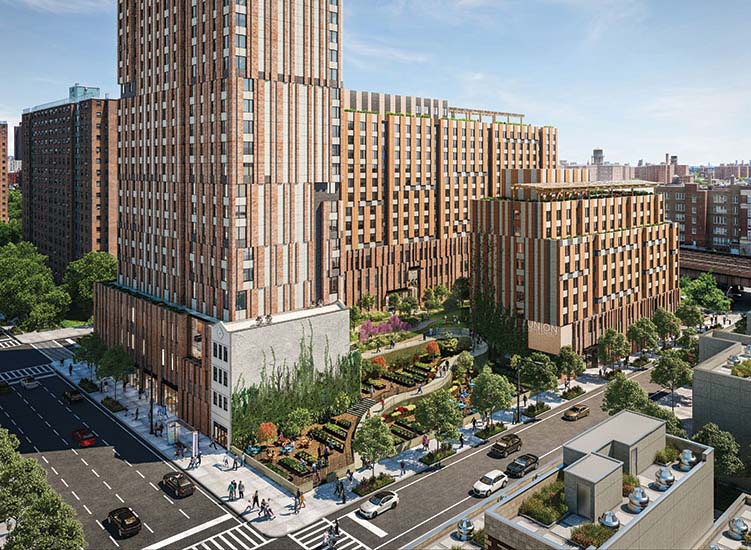
Sendero Verde, a three-building mixed-use complex rising in New York’s East Harlem, aspires to be a model of low-energy housing. Its tallest structure, a 37-story apartment building (foreground, far left), is expected to be the largest multifamily Passive House project in the world.
Images courtesy Handel Architects
The challenges of Passive House were multiplied by the variety of exterior wall types deployed by the developers (Jonathan Rose Companies and L+M Development Partners) for each of the complex’s three buildings. The two shorter structures use different combinations of EIFS, concrete block, and metal studs. The tallest building, meanwhile, is clad in brick over a metal stud backup. The assembly’s external mineral wool insulation passes outside the edges of the floor slab to avoid a thermal bridge. Additional mineral wool is used in an interior stud wall with both insulation layers coordinated to ensure a continuous thermal and air barrier at the window frame. The wall assembly has thermal resistance of R-20, about double a well-performing conventional wall.
The interior side of the tower’s wall assembly includes a “service cavity” so that conduit and electrical outlets are accommodated inboard of the insulation and vapor barrier. Otherwise, each wall penetration would have to be painstakingly wrapped to prevent air infiltration. Mechanically, the building combines heat-recovery ventilation with VRF condensers linked to air-handling units in each apartment. The project is designed to an EUI of 38.1, compared with the current New York multifamily median of 130.
Marrying the emerging technology of cross-laminated timber (CLT) with the Passive House standard will multiply the climate benefits of 201 Hamden, a 14-unit, five-story apartment building and co-working space slated to start construction this summer in Boston’s Roxbury neighborhood. Developed by the local design-build firm Placetailor, the project deploys Passive House tactics to reduce operating energy and emissions, while the wood stores carbon, avoiding the significant embodied emissions that would have been generated by steel or concrete construction.
Boston-area firms Placetailor and Generate are combining Passive House strategies with the carbon-storage capacity of mass timber to create a 14-unit apartment building (1) for the city’s Roxbury neighborhood. The building will include co-working space on the ground floor (2). Images courtesy Generate Architecture + Technologies/Placetailor
The project’s CLT expertise comes from Generate, an architecture firm created at MIT with team members from Harvard, and support from a Wood Innovation grant. The group developed a system with timber panels forming the floors, walls, and roof, providing structural strength through the continuous attachment of the panel edges, so that they work like a line of extra-hefty plywood boxes fastened together. From a building-code standpoint, the system is akin to heavy timber framing long used in construction. The structure will be fully sprinklered, and also protected by char that would form on the panels’ outer layer, preserving their structural integrity in the event of a fire.
The construction system is well suited to Passive House because of the low heat conductivity across the wood exterior panels, compared to masonry or light-gauge metal or wood stud-wall assemblies. Inboard of the metal rainscreen cladding, insulation is installed on both sides of the CLT panels.
The strategy is also expected to speed construction. Through BIM, the design will be translated into instructions to shop-cut the CLT members, explains John Klein, the CEO of Generate. Modular bathrooms will also be fabricated off-site. “There is a higher first cost but incredibly fast building erection,” he says. The surface of the CLT panels is appealing, so some wall and ceiling surfaces will be exposed in the finished units. But the interiors will also include drywall-and-stud cavities, allowing the concealment of electrical conduit, plumbing, and other services. The project’s angled roofs are designed to accommodate solar panels, which will help it achieve carbon neutrality.
Some skeptics have wondered if Passive House would work in America. But as the inventiveness and ambitions of projects like 201 Hampden, Sendero Verde, and NoVo demonstrate, the standard is taking hold in a variety of structures. “It is dominating the conversation around low-energy buildings,” says Yetsuh Frank, the managing director of strategy and programs at the Building Energy Exchange, a New York nonprofit. It has developed a track record of operational savings, says Frank, while other methods too often fail to meet promised performance. He sees Passive House envelope requirements migrating into building codes in such cities as New York, Seattle, and Vancouver.
The growing number of Passive House projects has spurred the development of materials and equipment that make compliance easier. Architects designing to the standard point, by way of example, to products from triple-glazed windows to mini-split mechanical systems, once exotic in the U.S. and now readily available.
Clearly, Passive House is an outlier no more.
Continuing Education

To earn one AIA learning unit (LU), including one hour of health, safety, and welfare (HSW) credit, read “Continuing Education: Passive House,” and the following supplemental material:
Then, complete the quiz. Upon passing the test, you will receive a certificate of completion, and your credit will be automatically reported to the AIA. Additional information regarding credit-reporting and continuing-education requirements can be found at continuingeducation.bnpmedia.com.
Learning Objectives
- Explain the concepts behind the Passive House standard and its benefits.
- Discuss the application of Passive House to large-scale projects, including new buildings, retrofits, and mass-timber construction.
- Describe some of the challenges of designing and building to the Passive House standard.
- Discuss the compatibility of the Passive House standard with other low-operational-energy approaches.
AIA/CES Course #K2004A

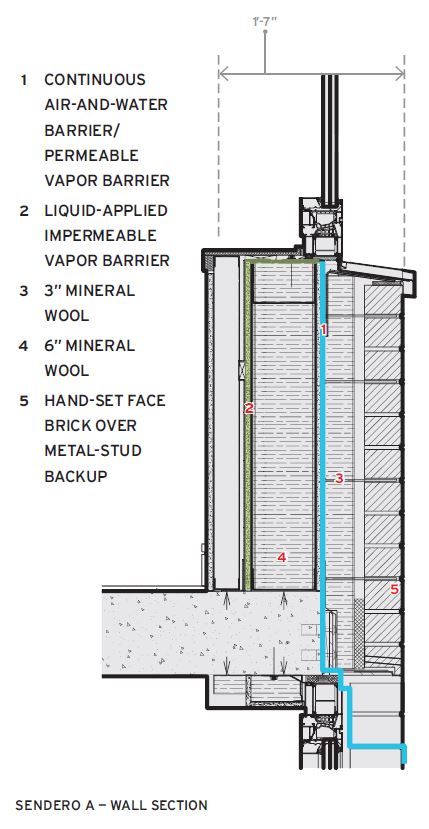
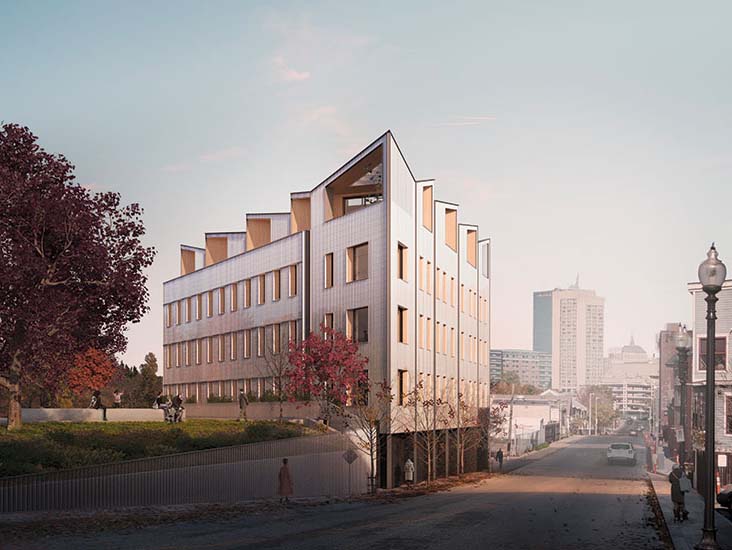
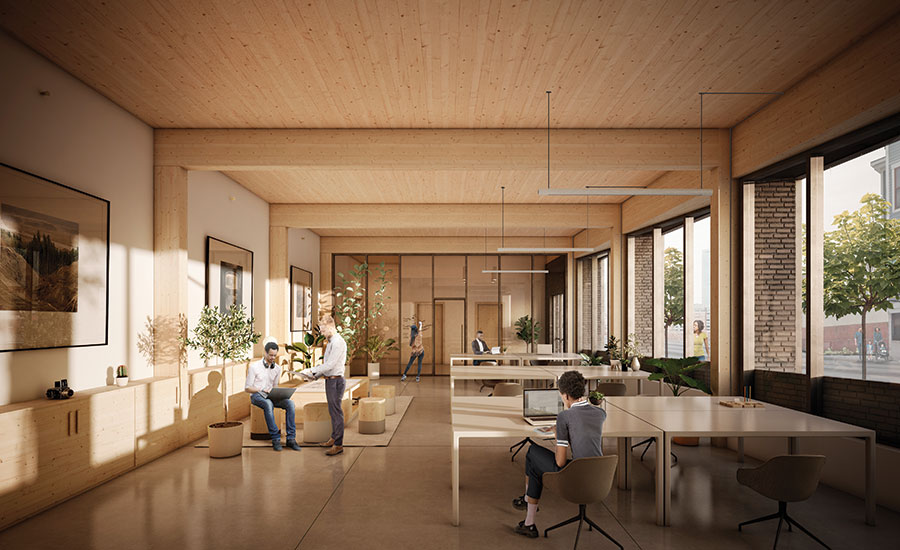

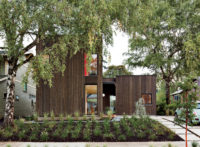
Post a comment to this article
Report Abusive Comment